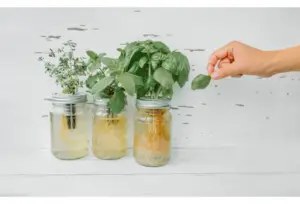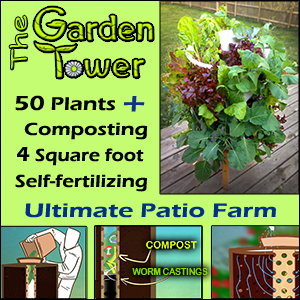
Are you excited about starting a hydroponic garden but have questions about how much water it’ll use? You’re smart to think ahead! Understanding your system’s water needs is key to being both an eco-conscious and successful grower.
Don’t worry, hydroponics can be surprisingly water-efficient. In this guide, we’ll break down the factors that affect water use, help you estimate what your setup will need, and share tips for minimizing waste. Let’s get started!
It’s Not Just One Number – Factors That Affect Water Use
If you’re hoping for a simple answer like “all hydroponic systems use 5 gallons of water a week,” you might be disappointed. But don’t worry – that’s actually good news! Understanding why there’s no single answer empowers you to manage your water use smartly. Let’s look at the key factors:
Your System Matters: A large Deep Water Culture (DWC) reservoir naturally holds more water than a tiny Kratky jar or a recirculating NFT system.
Plant Power: Leafy greens and fruiting tomato plants have different thirst levels. Your crop choices play a big role.
Where You Grow: Is your setup in a hot, sunny greenhouse or a cool, controlled basement? Evaporation rates will be vastly different.
You’re the Boss: How often you check levels, top off reservoirs, and maintain your system all impact how much water you actually use.
Key Takeaway: There’s no universal “gallons per week” number for hydroponics. But instead of being frustrating, this flexibility lets you tailor your setup and habits for water efficiency!
Estimating Water Use for Common Systems
Now, let’s translate those factors into real-world examples. We’ll focus on some of the most beginner-friendly hydroponic systems:
Deep Water Culture (DWC)
Starting Point: The size of your reservoir is key. For example, a 5-gallon bucket might be a good start for a single tomato plant.
Ongoing Needs: Primarily, you’ll be topping up your bucket as your plant drinks and some water evaporates. How often this refill is needed depends on your plant size, temperature, etc.
Nutrient Film Technique (NFT)
Reservoir Size: Typically smaller than DWC, but remember the water flows continuously.
Recirculation Impact: If your NFT system recirculates water back to the reservoir, this significantly reduces overall water use.
Drip Irrigation
Targeted Watering: Delivers water precisely to plant roots, minimizing waste if set up correctly.
Minimizing Runoff: Ensuring your emitters aren’t overwatering and that excess solution is collected will impact overall usage.
Important Notes
These are starting points! Your specific plant choices, setup design, and environment will further refine your water needs.
Start Small: As a beginner, it’s often wise to begin with smaller systems, letting you get a feel for water usage before scaling up.
Beyond the Basics – Plants Matter!
Think all plants have the same water needs in hydroponics? Not at all! Understanding how much your chosen crops actually drink is key for managing your system efficiently.
Small vs. Large Plants: A mature head of lettuce might use around 1-2 liters of water per week, while a full-grown tomato plant could easily need 5-8 liters during peak growth.
Growth Stage Matters: A fruiting cucumber plant might double its water needs compared to when it was just a leafy seedling.
Drought-Tolerant Options Exist: Some herbs like thyme or oregano are surprisingly adaptable to hydroponics and can thrive with less frequent watering.
Why This Matters
Matching Plants to your System: A thirsty plant in a small reservoir will lead to constant refills and might stress your plant. Choose wisely!
Flexibility: Hydroponics lets you experiment! Grow a mix of high-use plants (like fruiting peppers) alongside lower-need ones (like leafy greens) for variety.
Track Your Usage: The best way to learn is by observation. Jot down how much water different plants use in your setup.
Practical Tips for Water-Conscious Growers
Want to make sure those precious water drops are going directly to your plants? Here’s a deeper dive into simple yet effective water-saving techniques:
Your Best Tool: A Measuring Jug
It might seem basic, but accurately measuring how much water you use for refills is incredibly powerful.
Tracking Usage: Jot down these amounts in a notebook. This lets you notice if a plant suddenly gets extra thirsty (which could signal a problem) or if your system springs a leak!
Beat the Evaporation Monster
Shade: Direct sunlight on your reservoir speeds up evaporation. If possible, position your system in a shadier spot or provide a simple cover.
Lids: Even a loose-fitting lid on your reservoir makes a difference, especially indoors.
Climate Control: For indoor setups, keeping the temperature moderate and humidity from being too low helps to lessen evaporation.
Leak Detective
Regular Checks: Inspect all parts of your system – hoses, fittings around pumps, the reservoir itself.
Why It Matters: Even a slow drip might waste a surprising amount of water over a week or month.
Don’t Overfill
Top-Ups vs Overflow: Aim to add water as your plants use it, preventing your reservoir from overflowing and wasting water.
Smaller is Better: Sometimes, several smaller top-ups across a few days are more efficient than one massive refill where water may sit stagnant.
Extra Tricks
Mulch Matters:
For Media-Based Systems: If you use a growing medium like coco coir or expanded clay pebbles, a top layer of perlite or similar material helps slow evaporation from the medium’s surface.
Match Plants to System:
The Tomato Example: A thirsty fruiting plant will be happiest in a larger system (like DWC) where you’re not refilling constantly. A small, passive setup like Kratky wouldn’t keep up.
Go Grey (With Caution):
Research is Key: Thoroughly research safe and effective ways to filter and utilize certain types of greywater (like from showers or washing vegetables) in your hydroponic system.
Potential Savings: This can be incredibly water-efficient, but requires planning and precautions to ensure it’s safe for your plants.
Remember: Every little change adds up! By implementing these tips, you’ll be well on your way to growing a thriving hydroponic garden with minimal water waste.
Is Hydroponics Always Eco-Friendly?
It’s true that hydroponics often uses less water than traditional gardening. But to be truly eco-conscious growers, we need to look beyond just water. Let’s consider:
Energy Use: Pumps, grow lights (if used indoors), and other equipment consume electricity. The source of that energy matters (renewable vs. fossil fuels).
Fertilizer Origins: Many hydroponic fertilizers are synthetically derived. There are more sustainable options, but they might be harder to source.
System Materials: Plastic is common in hydroponics. Where does it come from, and can it be recycled at the end of its useful life?
It’s a Tool
Hydroponics, like any growing method, can be used responsibly or irresponsibly. Here’s how to tip the scales in favor of sustainability:
Optimize for Efficiency: All those water-saving tips from Section 4 help minimize the energy needed to pump and replace water.
Source Mindfully: Seek out fertilizers from sustainable origins whenever possible, and consider energy-efficient equipment.
Local is Greener: If your hydroponic lettuce travels further than traditionally-grown lettuce, that offsets some of the water savings.
Growing Greener with Hydroponics
So, how much water does your hydroponic system actually need? The answer, as you’ve discovered, depends on a variety of factors. But by understanding how your system, plants, environment, and habits impact water use, you have the power to be an incredibly water-efficient grower.
Remember, hydroponics offers great potential for minimizing water waste compared to many traditional gardening methods. Embracing the tips we’ve discussed and considering the wider impact of your choices will help you maximize that potential.
Don’t be afraid to experiment, track your water usage, and discover what works best in your unique setup. The journey to becoming a water-savvy hydroponic grower is an incredibly rewarding one!



